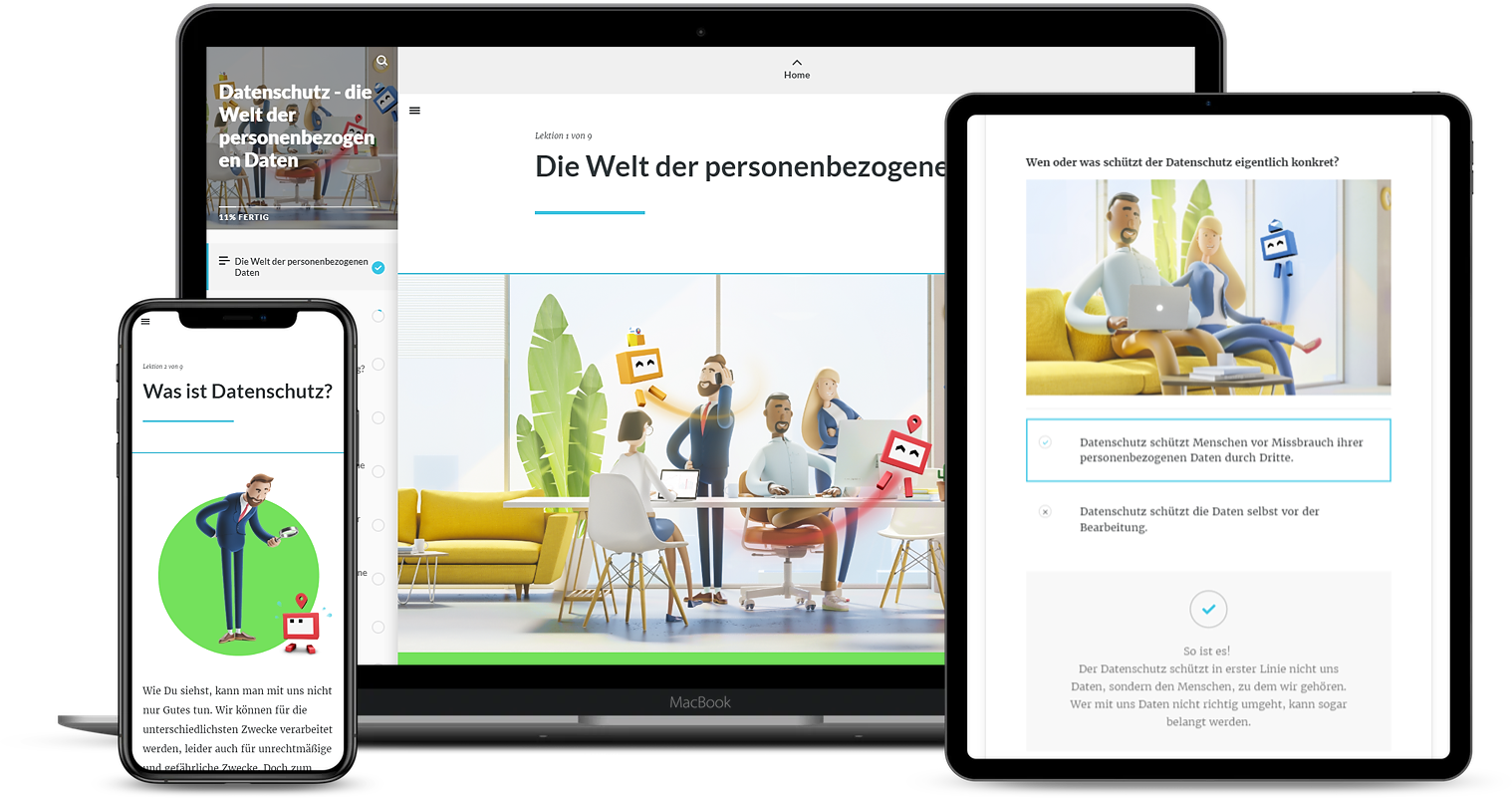
Five tips for more fun with e-learning
The company is offering a new e-learning course – does this still have the unfortunate effect of triggering the same feelings in your learners as their annual reminder to have the plaque removed from their teeth? It doesn't have to! We'll give you tips and tricks on how to make learning more fun by using GIFs.
Basics on the topic of GIFs
The first GIF had already been developed as early as 1987, but the idea of GIFs goes back even further. GIFs are, in fact, comparable to the good old flip book. The rapid flow of several individually drawn graphics creates a moving image for the human eye, basically an extremely short video without sound.

Not quite picture, not quite video: GIF stands for Graphic Interchange Format. GIFs are usually animated short clips without sound.
Even after more than 30 years, GIFs still enjoy great popularity, despite their somewhat dated appearance. The popular moving images are widely used, pixelated and limited colour spectrum notwithstanding, because they can be integrated almost anywhere and are easy to create and share. What’s more: Our digital communications, whether on Twitter, WhatsApp or Teams, would certainly be a lot less entertaining and descriptive without GIFs. Speechless? No problem! Joy, sadness, compassion, shame – no matter what feeling you want to convey, you can always find a GIF for it.
Good reasons for using GIFs in learning
Social media is not the only place for GIFs. They can also make learning more vivid and entertaining. We have compiled the most important arguments for the use of GIFs in e-learning for you:
- GIFs visually represent ideas and information in a few seconds
- A GIF is easier to follow than a series of still images
- GIFs usually run in a loop and are also perceived out of the corner of the eye
- GIFs therefore do justice to the attention span of Generation Goldfish (<8 seconds)
- Creating GIFs is much easier than creating high-end video content
- GIFs play automatically on almost any system
- GIFs trigger emotions. The stronger the emotion, the better the memory
- GIFs are mobile-friendly and ideal for micro-learning
tips for more GIF Ingenuity
The use of GIFs in e-learning offers several advantages. Use these short, vivid clips, for example, to make a step-by-step tutorial more entertaining, reinforce a key message, provide feedback, or make comparisons. We have summarised the most important tips for using GIFs in digital training courses for you below:
Tip 1: Offer your goldfish entertainment
Technological progress brings many opportunities and possibilities along with it, but at the same time, it is blamed for decreasing attention spans. You can counter that with GIFs. A good GIF attracts attention and triggers emotions, thus ensuring long-term retention. Boring, colourless GIFs reduce these effects.

Tip 2: No information overload
A rule of thumb should be: Only one theme per GIF. The individual short clips should not be longer than ten seconds and should be intuitively comprehensible. After all, true GIF genius is about explaining even complex facts in a simple and entertaining way (see point 1!).

Tip 3: Don't become Robin Hood. Or: No stealing for a good cause
Besides the popular genre of animal GIFs (keyword cat content), ultra short film scenes make particularly popular GIFs. Before you use a GIF like this from the Internet for your online training courses, however, make sure that you are not violating any copyrights.

Tip 4: Not everyone is familiar with Harry Potter
Consider the cultural background and age of your target audience. For example, if you use a meme from a film, ask yourself: Is my target audience likely to know the film? If a GIF is not clear and understandable, its positive learning effect is significantly reduced.

Tip 5: And the Oscar goes to... Hire a good protagonist
Do you have a recurring character in your other online training courses? Then provide your learners with a common thread and create GIFs with that character as well, for example, to provide feedback on a digital query. Passed the test? -> Rejoicing & Applause. Didn't pass the test? -> Sad face.

During an in-house imc BarCamp, Instructional Designer Stephan Urbanski and Senior Developer Frédéric Macchi presented a more detailed look at the potential of GIFs in the context of learning. The following sketchnote summarises the results of the session and all the important facts about learning with GIFs:

Contact person

![[E-Learning Punk] Christmas Special](https://images.im-c.com/wp-content/uploads/2020/12/imc_image_elearningpunk_Christmas_hero_2020_12_17.jpg)
Punky Talk #5: Sven R. Becker
The imc Board Member talks about basics like learning culture and target group orientation
Our fifth Punky Talk is our 2020 Festive Season Special. As a one-off, it is dedicated to the e-learning basics rather than to trends. After all, countless lists of top trends for the coming year are popping up wherever you look. We would rather use the year-end to ask: What are the fundamentals companies need to have in place before they can focus their efforts on the latest digital professional development trends in 2021?
And who is better placed to answer this question than Sven R. Becker? Sven was appointed to the Management Board of imc in January 2019 after many years of service for the company. During his studies, Sven already worked intensively on e-learning and UX design. Having paid close attention to the developments in the industry for years, he noted: 2020 was not just the year of corona, but also the big moment for “digital literacy”. A digital mindset now exists pretty much everywhere. Consequently, the relevance of e-learning is no longer limited to large corporations and companies in heavily regulated industries.
Sven recommends that anyone seeking to venture into the digital professional development world in the new year take an iterative approach. The important thing now is to get started! When trying to decide whether or not a trend is useful for your company, Sven suggests taking a closer look at the target group.
Sven also talks about costs, grassroots movements and the impact e learning has on corporate success.
Enjoy watching!

To watch this video, marketing cookies must be accepted. Click on the play button to accept. You can find more information in our cookie banner and in the privacy policy.
(Note: under "settings", you can turn on the English subtitles for this interview)
Contact person


User-generated elearning content meets artificial intelligence
From 0 to 100 in 60 seconds – create learning content faster than ever with imc Express
Creating and digitising learning content has never been this easy. The days of substandard corporate e-learning courses are over. The new imc product claims as much. Starting in the first quarter of 2021, imc Express lets absolutely anyone quickly produce didactically prepared learning content with ease.
We spoke to Oliver Nussbaum about how exactly that is meant to work, and what exactly sets imc Express apart from traditional authoring tools. The Managing Director at imc in Austria was instrumental in the development of the software.

Hello Oli! Thank you for taking the time. What is the idea behind imc Express and where did the product come from?
Authoring tools have been around for over 20 years, it’s an established software category. What has, however, increased dramatically in recent years is the need for user-generated content: Learning content created directly by various knowledge holders in a company.
Digitising knowledge and making it accessible to everyone is a major challenge in any company. Yet, this options simply didn’t exist. That is why we developed imc Express.
What is the difference between imc Express and authoring tools like imc Content Studio?
To put this into perspective: An authoring tool is like Photoshop. It allows you to do very complex things. You can move every pixel separately. You can fine-tune every shade in every cropped image. Yet, without prior knowledge or some initial training, the program will simply overwhelm you.
In comparison, imc Express is like an Instagram filter. You have an image that you want to post, and simply want to optimise it quickly. Instagram will automatically suggest various filters, you select one of them ... and you’re done. Instagram handles the design task.
Applying that same concept to Content Studio and imc Express means that you need to know your way around authoring tools to use them. You need certain skills. Once you acquire them, you can access a wealth of configuration options.
You can test things and design learning content exactly to your liking. Meanwhile, imc Express is geared towards a much broader user group. It is intuitive and requires no prior knowledge.
Why not simply use PowerPoint?
PowerPoint doesn’t help with didactic conceptual design, implementation or presentation. The company can store its own corporate design in imc Express which is then automatically adopted. What’s more, the software leverages artificial intelligence (AI) to identify what type of content is being prepared, and places the contents in the corresponding templates.
What are the greatest challenges for people not dealing with learning content creation on a regular basis?
There are three aspects. First of all, 95 % of the people don’t have the slightest inkling of good design. That may sound harsh, but it’s true.
Secondly, few people understand how to structure learning content didactically. How can I design my training to ensure that people enjoy it and remember it well? How do I package all that into an interesting and conclusive process? Those key points are extremely important for the conceptual design while also requiring significant time investment.
Finally, there’s a technology hurdle. Most people are overwhelmed when a software offers too many features. They don’t have the time or energy to really learn about them, and will struggle to figure it out. That’s a motivation killer.
This is why we set imc Express up to “dictate good design”. Instead of making the user deal with countless possibilities, AI makes the decision for them and optimises content realisation.
Say, for example, you want to describe a product. You simply select the product description template and the software will give instructions, such as: “Enter a short text that describes your product in one sentence.”
Are there other applications that use AI?
Absolutely. It’s a major topic in the creation of barrier-free content. imc Express uses AI to automatically set the right tags in the background to every image you insert to correctly describe and store the image.
For instance, if you insert a picture of a red cat, words like “animal”, “cat”, or “red cat” are automatically tagged. Naturally, that also allows other users to find your image directly if they do a search for “cat”.
imc Express can also play any spoken text directly – that’s known as text-to-speech – or describe images using the tags. It goes without saying that the software can be used optimally on any device, it s both adaptive and responsive.
How does the creation of multilingual content work?
That was a key aspect for us. What usually happens is this: You prepare something and send it to a translation agency. When you receive the translated text back, you have to return it to the presentation format.
With imc Express, you simply tick the box for the additional languages you want to prepare the training in. The training course is then automatically and directly translated, staying with the corresponding layout. While it will still need a linguistic review, the time savings are enormous.
Can I integrate the content I created with imc Express directly into the learning management system?
Of course! It only takes one click, and works with all learning systems. Now, the big advantage with our LMS is that it supports automated import with shared users and rights management. But we also operate SCORM and xAPI interfaces.
OK, in a nutshell, who can or should work with imc Express?
imc Express really is suitable for everyone – from marketing manager to apprentice, from consultant to production line workers. Every company can use the software to digitalise its knowledge. We equally see great potential for schools and universities. The tool is made for anyone who wants to share and digitalise information and knowledge.
Our mission is to enable all employees to create great learning content by themselves to make poor e-learning content a thing of the past!
Thanks for your time Oli and let's start creating awesome content!
More about imc Express
If you would like to learn more about imc Express please check here for further information.
I have been working in the Marketing & Communication Team at imc since March 2019. Communication, creative content and social media are my passion. "KISS - Keep it short and simple" is my credo.
To explain complex content in an understandable way and thus make the topic of e-Learning accessible to everyone is an exciting challenge every day.
Privately I love to read, play poker and travel a lot. I am always happy to receive feedback or suggestions.

A plea for diverse learning content
Why you shouldn’t neglect diversity in e-learning projects
Diversity is increasingly becoming a hygiene factor in our working world. We have arrived in a time where young people are specifically looking for employers that allow them to unleash their potential and to be themselves. Yet, that is not the only reason companies benefit from strategic diversity management. In the German imc E-Learning Inc. podcast, Mohanna Arzamandi, Chief Learning Officer at Microsoft Germany, recently announced: “Diverse teams are better at problem-solving.” Mohanna knows that the Diversity Management and Corporate Learning segments are closely linked.
This starts with training intercultural competences, encompasses barrier-free learning offers and involves illustrating diversity in the actual learning content. We discussed that last point with our E-Learning Content Project Manager Kenneth Littlepage.
“The diversity you want must also be reflected in your learning content.”

Kenneth Littlepage hosts the English-language imc E-Learning Brunch podcast while also looking after e-learning content as a project manager – a role he has held since 2014. Here, he supports clients from the initial design of learning content to its realisation and implementation. We spoke to him about the role diversity plays in e-learning content projects.
Hello Kenny! What does diversity mean to you?
Kenny: Diversity has several meanings. Most people tend to think of cultural diversity when they hear the term. Yet, there are other aspects of diversity, like workforce or job diversity. For me personally, that primarily means not just sticking to the same routine day in day out, but also being able to realise projects that push the envelope.
You are project manager at imc, looking after clients like the UN, UNICEF, Lufthansa and PwC. How much do your clients really bring up diversity?
Kenny: It always depends on the company. Cultural diversity, at least, plays an increasingly important role in the e-learning projects we realise together with these companies.
Is there a difference between public institutions, national and international companies?
Kenny: Yes, I would say so. The more global a company is, the more sensitised it tends to be to diversity issues. They will often be very direct in their project specifications. Sensitisation is less pronounced among local companies. Then we need to interject and ask: “Hey, should we make a point of XY?”
What specific options are available for realising diversity in content projects?
Kenny: That depends very much on the learning content. Of course, if the presentation revolves around a situation with two persons, it is impossible to consider all aspects of diversity. However, multiple characters can be integrated into most web-based trainings, enabling us to represent different genders and nationalities. We like to use animations. Drawn characters allow for a bit of distance.
How important is it that the content fits in with the real world? For example: If 90% of the managers are white and male, does presenting a multicultural learning environment not come across as dishonest?
Kenny: The real question is: What led to the current situation? Was it intentional? Did it happen by accident? Is the company still in the development stage? Is it striving for a more diverse direction? If you want diversity, I don’t believe it is dishonest to show your vision for the future.
What other challenges do you come across? What do you pay special attention to?
Kenny: Usually, it’s gender and nationality. Most of our clients have international operations and want to ensure that the learning content is applicable to as many employees as possible. On the other hand, we also work with NGOs where religion plays a major role as part of the culture. We then try to bring in characters wearing a headscarf based on religious customs.
“Diverse teams should be involved in developing diverse learning content.” Do you back that statement?
Kenny: To me, that’s very much the same as saying: “People who have children cannot take advice from someone who doesn’t have kids.” So, if you don’t have kids, does that mean your opinion is not valid? You are not allowed to say anything? I believe that someone trained on the subject, or even someone very open to it can handle that without any issues. But, of course, it is far more authentic for the learner if the content illustrating diversity was developed by a diverse team. It is far more difficult to represent diversity and write about it when it doesn’t exist.
How important is diversity education? Is more learning content on the topic needed?
Kenny: Yes, I think it is needed. I also believe that governments must be involved a lot more, because they provide directions and set examples. On company level, you need to clarify and provide information: How does our company handle diversity? What do we offer our employees? Now, personally, I haven’t seen any learning content yet that explicitly addresses the topic.
Thank you very much for the exciting interview, Kenny!
tips for creating content that reflects diversity
The interview shows that there are different approaches to including diversity in content creation. To make sure you’re starting on a solid footing, we added our own insights to the points Kenny made and summarised them in 5 tips.

Observe your environment
Ask yourself: What does diversity mean to my company? What do we stand for? For example, if promoting women in leadership positions is a strategic objective, the learning content should reflect that.

Sometimes, more is more
Featuring only one protagonist in the leaning content makes it difficult to represent diversity. Extras and avatars can be used to make the content appealing to multiple target groups, such as different nationalities represented in the company.

You are not the standard
Put yourself in different participants’ shoes: Is the learning programme designed to make it accessible to every employee? Can it be used by employees with visual or hearing impairment? For example, content might be read out from slides, because it cannot be assumed that everyone can read the text on the slides.

Education is the start
Reflecting diversity in your learning content is important – as is communicating to your employees what diversity means to the company and what specific measures are used to drive it. Why not outline your company’s take in some learning content on diversity?

Train the right topics
Now that we’re talking learning content: Provide content to your employees that promotes an open corporate culture, as well as open and honest interaction between employees. For example, training on “intercultural competences” can improve collaboration between different cultures.
In our next Punky Talk, we want to delve deeper into the topic of diversity in e-learning projects and speak to a company that deals with diversity on a grander scale and wants to share its experiences with you.
Contact person


Don’t call it compliance!
5 success factors for effective realisation of
"boring" trainings
Spontaneous yawning, irritated eye-rolling and sudden appearance of urgent appointments are some of the most common side effects of announcing the latest compliance training. Yet, it is crucial that employees internalise the learned content from important training courses on topics such as data protection or fraud prevention for the long term. This can only be achieved if the learning experience is great. We reveal how that can be done.
“It really is very simple: The more complex and dry a topic, the better the experience needs to be for the learner,” Sven R. Becker, learning expert and Member of the imc Executive Board sums up. As much as the learning experience is hyped up and features in the learning management system (LMS), it often falls by the wayside in company-specific training.
Topics like the latest GDPR provisions or IDD training as soon required in the insurance sector might not be met with great enthusiasm – but they are extremely important. Employees not only need to understand these topics, they must also internalise them and apply them in their daily work.
Creative realisation of dry topics like fraud prevention
Audi is leading by example. The automobile giant ventured to try a courageous concept: Web-based training modelled on “Sin City” is leveraged to train all employees in fraud prevention. Right from the outset, it is obvious that this training course is different. Usually, a participant would click “Start training now” to make a start on their training course. Here, they are greeted with the following text: “Welcome to Fraud City. The city “eats” its residents – skin, hair and all. We hope you’re up to it. Enter at your own risk.”
Throughout the course, the participant accompanies Detective Fraudless who investigates fraud cases. In this game setting, the participants become familiar with the criteria used to identify cases of fraud while also becoming sensitive to suspicious behavioural patterns.

Laura Schumacher, Training Officer at Audi, emphasises: “We very deliberately wanted to provide a different kind of training course that is fun and sticks with you, especially for this sensitive topic.”
This unusual concept is paying off: On the intranet, countless Audi employees made largely positive remarks on “Fraud City” – rather remarkable for compliance training.
Standard training for ever-changing guidelines
Since not everyone can justify the time and expense of highly customised training courses, a large selection of off-the-shelf content (OTS) is also available. In particular, this is a suitable solution for contents or certifications requiring adaptation due to regular updates, legislative changes or new guidelines.
Such off-the-shelf training courses fit the bill for product training required in the insurance, banking, pharmaceutical or medical sectors. It is, however, important that providers hold relevant certificates and accreditations and are able to guarantee automated learning content updates.
TIP
Ensure that your provider is an accredited educational service provider and guarantees that content is always up to date.
These standard training courses can easily be mapped in the LMS and facilitate complete documentation and certification of all employees. Vivian Porath is responsible for OTS contents at imc. She is confident that these training courses need not be boring at all:
We have received outstanding feedback from our clients, especially on our standard data protection training. Our clients feel the design hits the spot, being neither too comical nor too serious.
One reviewer stated that they thought the training course achieved a perfect technical balance. Other courses they attended had been either too superficial or looked at the subject in such depth that they had switched off. We were thrilled to hear that. After all, we strive to present the GDPR in such a way that anyone can gain from it. Many employees have no need to dive deep into the subject matter. Rather, they must be sensitised to the topic in general.”

Vivien Porath
It still holds true: Employee motivation and a great learning experience are key. Without them, learned content is forgotten faster than you can close the next cookie banner.

LMS integration
Training alone is not enough – whether based on customised or standard content. Traceability must also be ensured. This is best done with a suitable LMS that allows admins to allocate relevant training courses to each target group, and should also include setting end points and establishing escalation management.
Say, for example, insurance expert Ms Smith belongs to a group of employees who must earn a specific number of IDD points . The administrator can create an automated alert for relevant courses in the system. If she fails to complete the training by a certain date, she will receive repeated email reminders. At a pre-defined date, her direct supervisor can also be informed.
INFO
Since 2018, all insurance intermediaries throughout Europe have been obliged to undergo further training within the framework of the Insurance Distribution Directive (IDD). The number of obligatory training hours varies from country to country.
What to base your choice on
What should clients pay attention to when buying compliance training? Sven R. Becker summarises:
1. First of all, understand your target group. Does the target group need to acquire in-depth specialist knowledge? Or is sensitisation the primary goal? Your answer to this question must be reflected in the technical presentation.
2. It is generally advisable to establish a basic understanding for sensitive topics across the entire organisation, a compliance mindset. Each training course and each measure must be positioned within this mindset. It is crucial that management is setting an example. Integrating senior management into the training course is often helpful, and asking them to design realistic case studies can help learners see how the content applies to them.
3. Standard training is better suited to content more general in nature, as the provider must ensure that it is up to date. However, if a topic is specific to a sector or even just the company, it helps to customise at least parts of the training and only filling the gaps with standard content.
4. Ask yourself for how long you want to use a training course. If contents requires frequent adaptation, OTS content is often a better choice – provided that certifications and updates are guaranteed.
5. Don’t call it compliance training! The term alone is like a red flag for many employees. It pays to be brave and find a different name. Surprise your learners with training courses that polarise and stand out. This makes your contents more memorable than with run-of-the-mill courses. And maybe you can even have your employees enjoy the training – without the yawns.
Further information
If you would like to learn more about off-the-shelf content or our custom content, please check the related pages and feel free to contact us.
You can also check this webinar recording (German only) about the topic of compliance.
Contact
I have been working in the Marketing & Communication Team at imc since March 2019.
Communication, creative content and social media are my passion. "KISS - Keep it short and simple" is my credo.
To explain complex content in an understandable way and thus make the topic of e-Learning accessible to everyone is an exciting challenge every day.
Privately I love to read, play poker and travel a lot.
I am always happy to receive feedback or suggestions.

Punky Talk #4: Dr. Fabian Kempf
The specialist for virtual classrooms firmly believes: “Poorly modelled 3D avatars are not helpful in the virtual world.”
Our fourth Punky Talk is fully dedicated to the topic of virtual classrooms. After all, digital lessons are the best answer to the corona pandemic and the associated prohibition of contact in many places.
The article “Rock 'n' roll in the (virtual) classroom” already examined in detail what a virtual classroom is and how it works. It then goes on to present three providers of virtual classroom tools. Vitero is one of these providers. The highlight of the Vitero software is its user interface. It depicts a meeting room of sorts which is based on the real world and arranges lesson participants around a conference table. Nevertheless, Managing Director Dr. Fabian Kempf firmly believes that poorly modelled 3D avatars are not helpful in the virtual world. In this interview, he shares his tips for adding opulence and glamour to the virtual classroom instead.
Enjoy watching!

To watch this video, marketing cookies must be accepted. Click on the play button to accept. You can find more information in our cookie banner and in the privacy policy.
Summary of key points from the interview
- Virtual classrooms can help companies through the difficult corona period, and even save them from bankruptcy.
- Since speed is paramount, Vitero had to adapt its processes and launched a quick-start offer specifically tailored to the current situation.
- The crucial element for developing a close teacher-student relationship is regular exchange, rather than physical proximity.
- Trainers should therefore focus on interaction and collaboration to strengthen the relationship.
- Good training allows a trainer in the virtual room to respond to common complaints like “I cannot hear you” with confidence, and design interactive lessons that generate discussion.
- LMS and virtual classrooms are a perfect match. A learning management system with web-based training achieves independence in terms of time, inclusion of a larger target group and longer applicability – the half-life of contents. A virtual classroom removes the need for elaborate content creation. Moreover, live communication means that any comprehension issues can be addressed directly. Combining the two tools creates synergies between their benefits and provides optimal support for the realisation of blended learning concepts.
- Incorrectly modelled 3D avatars are rather difficult to navigate in the virtual room. A more effective approach is to limit 3D content illustration to specific points where this boosts visualisation.
Contact person


Is coronavirus bringing immersive learning to the forefront?
Jennifer Fritz explains the potentials that virtual reality offers as the coronavirus crisis continues
Student exchanges in the US, a semester abroad in China – immersion, which can be described as switching to a completely different (language) environment, continues to be the most successful (language) learning method in the world, as well as the one with the most thorough research behind it. It’s no surprise then that virtual reality (VR), which is often mentioned in the same breath as augmented reality (AR), works much the same way.
While AR enhances our “true” reality with virtual elements, VR is instead designed to fully immerse us in a virtual world.
Needless to say, both immersion and virtual reality have become very relevant topics ever since the coronavirus crisis started. Just think of the number of people setting up Zoom or Skype meetings to stay connected and reduce the isolation that comes with social distancing as much as possible. Now think of the limits of these meetings when it comes to really making eye contact, branching off into one-on-one conversations, and even moving to a different room. That’s where VR can help.
Jennifer Fritz has worked as a learning concept designer, storyteller, and consultant for companies such as Virtual Identity AG and imc AG. Her passion is digital learning and teaching, and as a former member of the First German Business Association for Immersive Media (EDFVR), she knows that the future in this area belongs to virtual and augmented reality. In fact, she has seen a trend towards social virtual learning since the beginning of the coronavirus crisis.
A key observation by the concept designer, storyteller, and consultant: “Now we’re suddenly doing things that would have been completely unimaginable just a few weeks ago.”
Hi Jenny! How would you describe the role of augmented reality (AR) and virtual reality (VR) in your day-to-day routine?
Jenny: Well, as you probably know already, both are incredibly exciting new technologies. What’s worth pointing out is the fact that they’re finally seeing some proper development nowadays, and so there’s a lot of room still left for experimenting. When it comes to my personal life, I really like using entertainment applications such as Wonderscope, for experiencing stories in AR, and Beat Saber, which is a rhythm game.
In addition, I also work with these technologies whenever it makes sense to do so in my projects. In fact, I can’t overstate just how strongly I believe that AR and VR are both opening entirely new possibilities in terms of learning and storytelling.
Now, there are still many clients who are not too keen on the costs or the technology at this point, but I think it’s important to point out that VR in particular can really help us deal with the isolation resulting from social distancing during the coronavirus crisis and give us that sensation of “being there” that you don’t really get when working from home. And it goes without saying that an obvious application is daily VR meetings, but it can also extend far beyond that and include things such as professional development training and even onboarding. Moreover, the importance of this becomes more obvious when we consider that people have now been working from home for weeks and that new employees keep being added, which means that companies that have already implemented VR onboarding training have a clear advantage.
This reference to onboarding is really interesting because, as you’ve pointed out, it’s a new and exciting area of application. Now, it’s probably reasonable to assume that most people think that VR is particularly well-suited to training for high-risk scenarios – what other kind of applications and scenarios are there?
Jenny: Well, like you’ve said, VR is ideal for simulating dangerous situations and processes with valuable raw materials. But it’s important to keep in mind that VR training also makes sense when not enough training stations are available.
And once again, I can point out a good example related to the current coronavirus pandemic, this time derived from the fact that it’s a high-risk situation for medical staff. More specifically, a new VR training system has recently been used to train 17,000 doctors and nurses for the COVID-19 pandemic, which is something that would have been completely impossible to do with traditional training given the number of people. Most hospitals are overburdened and don’t really have capacity for urgently needed training, so a virtual space made it possible for the training participants to get their bearings in regard to the new coronavirus reality without having to put their own health, or that of their patients’, at risk. And on top of that, using virtual reality meant that valuable PPE was conserved. So if you think about it, this is a perfect example of every single factor in a single scenario: Compensating for insufficient training stations, conserving crucial raw materials, and providing safe training for a hazardous situation.
It’s also important to note that we’re seeing new scenarios that seem to be viable to various degrees arise on almost a daily basis right now. Needless to say, high-risk scenarios and limited capacity have been firmly established as cases where virtual reality training makes sense, but we’ll see others be confirmed as well with time. As I mentioned earlier on, social distancing makes it very likely that we’ll see – at least temporarily – areas in which VR training will replace what would normally have been in-person training, such as communication skills and sales.
You mentioned concerns about cost earlier on. Aren’t AR and VR learning methods incredibly expensive in terms of hardware and content creation? How can someone decide whether it’s really worth it?
Jenny: With the Oculus Quest’s launch a few months ago, we now have a headset on the market that offers full mobility in a virtual environment and that doesn’t need a PC or external tracking elements – all at a price of 400 euros. This saves additional costs that would normally be associated with equipment, and the head-mounted display (editor’s note: AR glasses) is easy to use. In other words, we have an affordable option for the HMD at least.
Now, in regard to content creation, it really comes down to what the company in question wants, and we’re talking from real 360° photos to highly complex 3D animations – I honestly think there’s an option for every budget out there by this point. Basically put, the market has stabilized. Of course, however, it’s important to consider that virtual reality training is really only worth it beyond a certain number of users, which is why it’s absolutely necessary for companies to sit down with the relevant service provider before beginning a project and analyse the target group, the specific needs, and the general conditions involved. This would then yield a recommendation on which format and which technology to use.
What are some important considerations when designing VR and AR experiences? Do you have any specific tips?
Jenny: Well, it goes without saying that it’s important to draw several firm distinctions here. AR is used on a multitude of devices ranging from smartphones and tablets to smartglasses, so the size of the device really matters. One thing that people should always do, however, is to make sure that their applications aren’t too difficult to use regardless of whether they’re using gestures or touch. Controls need to be clear and easy to use, and there’s hardly anything as frustrating as not knowing how to make progress when taking a training course. Another thing worth considering is that voice control and a generous use of audio and audio effects can be very good ideas for both technologies. In fact, even music can be ideal depending on how cinematic the end product should be.
Having said all that, there is one nugget of wisdom from “normal” e-learning that remains intact for these two new technologies too: Interactivity maximizes learning. In other words, it’s important to give the person taking the course regular opportunities to explore and try things out and interact with the course contents and the learning environment.
What should we keep in mind when introducing AR/VR – in terms of the target group, for example? Would it be true that the younger and more familiarized with digital tools, the better?
Jenny: I know as many “young people” without an affinity for digital tools as “old people” with that affinity. I think it’s less a question of age than of wanting to do it. However, incorporating a phase for getting used to things and a tutorial at the beginning of a training program is never a bad idea.
On top of this, it’s important to remember that HMDs weigh a certain amount and that the duration of the course should usually be shorter than normal due to this.
And finally, it’s absolutely crucial to make sure it’s not just a one-time gimmick to be all cool and cutting edge. If someone really wants to use XR learning, it’s important to make a long-term commitment and consult with a professional to identify the learning scenarios that make sense, the devices that should be used, and the way that implementation and maintenance should work.
In addition to a phase for getting used to things and tutorials, are there any other tips you can offer for improving the willingness of students and trainees to use AR/VR learning applications?
Jenny: I think that’s happening by itself right now, to tell you the truth. The exigencies arising from the coronavirus pandemic have essentially made people much more willing to try out new things. In fact, Google Classrooms with VR are enjoying a surge of popularity right now, and we’re seeing less obvious solutions as well, such as people moving their travel plans to their VR headsets due to the lack of other options. And many others are now going to the museum or theatre with (web) VR applications. Now we’re suddenly doing things that would have been completely unimaginable just a few weeks ago.
Now, it’s worth mentioning that what has worked particularly well for me is introducing the new technology in a very relaxed and casual way. Simply bring the VR headset and let the person put it on and try out a couple of simple applications and they just usually realize right away that the technology can be fun and is nothing to be afraid of. And, of course, having an advocate team within the company that knows its stuff and can answer questions can be really helpful when introducing things.
What are some current trends in the field of immersive learning and where are things headed?
Jenny: I think the most solid trend is probably that the coronavirus crisis has resulted in a new push towards joint virtual learning. And both social learning and virtual reality were already on every single trend list before the pandemic started, but now we’re seeing a move towards social virtual learning. I think we’re definitely going to see a bunch of new products hit the market in the next few months.
I also think that we’re going to see a greater integration of WebVR snippets into “normal” training courses, as that’s a great way to test the waters with this new trend.
Thank you very much for the exciting interview, Jenny!
Contact person


The quiz show phenomenon in e-learning
Understanding why companies should rely on quiz apps in professional development
Learning by quizzing: are you always looking for entertaining fun facts for your next small talk? We feel the same way. That's why today's E-Learning Punk article starts with a quick question for all the British Royal family fans.
The Queen…
- A: celebrates her birthday twice a year
- B: has already had a little plastic surgery
- C: swears by yoga in the morning
You will get the answer at the end of the article. First of all we want to look at where the interest in quizzes comes from, how companies can make use of them in training and what needs to be considered.
The success of quizzes depends on the mix
Jeopardy and QuizUp are just two well-known quiz examples. Quizzing is simply fun, it activates the reward centre in our brain and provides flow experiences with the right questions. Companies can also take advantage of this and use quiz apps in professional development. The quiz apps combine the advantages of mobile learning and game-based learning.
Various game elements are used, which in combination contribute to the success of the format. Here are the three most important elements of quiz apps:
Avatars
They are used as identification figures. Wonderwomen, Jack Sparrow or Count Dracula - my avatar allows me to present my innermost self or to slip into different roles.
Competition
By competing against other players, my ambition is aroused (fun fact: this is especially true for men, women are usually more reserved). When I play in a group, I feel like I'm part of something bigger. This phenomenon is also described as "epic meaning".
Feedback
If I answer a question correctly, there will be points and I will be promoted to the high score list. If I answer a question incorrectly, there are no points. It's that simple. The feedback is clear, honest and direct.
Quiz apps as a learning tool?
With BizQuiz, IMC also has a quiz app that uses the three elements just described. We evaluated the data of about 100,000 players and came to the result that quiz apps in continuing education are a learning trend that - when used correctly - leads to really amazing success:
Most players play daily - even on weekends. As a result, after just three weeks they know about 1.5 times more than at the beginning.
That makes sense. People are learning by repetition. By repeating something over and over again, it becomes an unconscious competence for me and takes place automatically at some point - like typing with ten fingers or flashing while driving. "We only see limitations when a target group simply has too little basic knowledge for the topic," says Oliver Nussbaum, IMC Managing Director in Austria and quiz master. But here we also have to say, the right mix makes the difference.
Areas of application for quiz apps in companies
Experts use quiz apps at various points of the learning journey and combine the quizzes with other tools such as digital learning cards and classroom training. Sounds complex? Want to know more? Ok, here we go. Quizzes are ideal whenever the level of knowledge needs to be tested or knowledge needs to be consolidated:
Testing the state of knowledge
At the first point of the learning journey, quizzes helps to determine the status of the learners and to discover knowledge gaps. Ideally, the learning content is tailored to the results.
Consolidate knowledge
After face-to-face training or e-learning, quizzes can make a significant contribution to consolidating knowledge. Perfectly suited are quizzes that run over a period of two to three weeks and reward with a real prize at the end.
tips for the use of quiz apps in continuing education
So now we know what elements make quiz apps so successful and at what point in the learning journey quizzing can provide a bit of fun and motivation. Finally, we have a few tips for you to make sure that the quizzes don't miss their effect and you don't get bored:
- Limite the maximum number of games that can be played per day.
- Do not use quizzes in an inflationary way. Instead, use them mainly for topics of strategic importance and with a manageable number of questions.
- Pay attention to the flow channel when creating questions. A good question should not be too difficult, but also not too easy.
- Provide small incentives that have a positive effect on the status of the winner, for example an exclusive meeting with the management board.
- Leave the game as what it is: a game. Not a formal learning measure. Don't force your learners to participate.
The right answer is A, by the way.
Contact person


Punky Talk #2: Roman Rackwitz
The second Punky Talk focuses on game-based learning, quiz-based learning and AI . We are hosting Roman Rackwitz, gamification guru and CEO of Engaginglab GmbH.
Roman has been involved in game thinking and gamification since 2007. He has already been named one of the top 10 gamification experts in the world. He describes himself as a naive optimist who rebels against the mindset that gaming were a waste of time. He wants to break down barriers and make games a natural thing, even in a corporate environment.
In the interview with E-Learning Punk moderator Vanessa, he talks about why failure is so important for our personal progress, why content is king but context is god, and why rewards should act as feedback – not bribery.
The interview was recorded live at LEARNTEC 2020 in Karlsruhe (Germany).
Enjoy watching!

To watch this video, marketing cookies must be accepted. Click on the play button to accept. You can find more information in our cookie banner and in the privacy policy.
(Note: under "settings", you can turn on the English subtitles for this interview)

The quiz show phenomenon in e-learning
Quiz apps for learning? For sure! We will talk about the success factors of quizzes, introduce areas of application for quiz apps in companies and give you 5 tips for their use in continuing education.

Go for Game-based Learning
We talk about what lies beneath the trend of this playful knowledge transfer method. We explain why it works so well and present 3 application scenarios for learning games in the company.
Contact person


Punky Talk #1: Karlheinz Pape
The founder of a popular German learning community talks to us about self-directed learning
In our E-Learning Punk series, we publish a new article on current digital training trends each month. The last three months have been dedicated to the following three trends: video-based learning, blended learning and mobile learning. Now, in the first Punky Talk, E-Learning Punk editor Vanessa talks to Karlheinz Pape, founder of the German Corporate Learning Community (CLC), about these topics, but also about his favourite, self-directed learning.
With the CLC, Karlheinz has established a community network that drives new forms of learning. In our interview, Karlheinz appeals to the crowd to reject their prejudices against learning with video. He also explains why Twitter is his number one learning booster and why mobile learning is an artificial term for him.
Listen for yourself below.

To watch this video, marketing cookies must be accepted. Click on the play button to accept. You can find more information in our cookie banner and in the privacy policy.
(Note: under "settings", you can turn on the English subtitles for this interview)
Contact person
